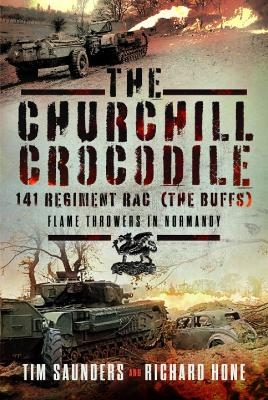
The Churchill Crocodile: 141 Regiment RAC (The Buffs)
Flame Throwers in Normandy
Seiten
2024
Pen & Sword Military (Verlag)
978-1-3990-3998-7 (ISBN)
Pen & Sword Military (Verlag)
978-1-3990-3998-7 (ISBN)
A case study of the introduction of a new weapon system.
The British Army started the development of flame throwers in 1938, but progress was slow and interest was side-lined after Dunkirk while the army reequipped. Investment in a flame-throwing tank only returned to the agenda thanks to interest by General Percy Hobart when he developed ‘funnies’ for 79th Armoured Division and the concept gained the support of General Sir Alan Brooke.
141 (The Buffs) Regiment RAC had been converted to Churchill Tanks at the end of 1941 and in early 1944 they were earmarked for another change of role to the Crocodile conversion of the new Mk VII Churchill tank. This flame throwing system was secret and started to arrive with the regiment in April 1944. By D-Day only one squadron was equipped and trained, with space on the landing craft only available for two troops to land in support of 50th Division.
The rest of the regiment arrived by the end of June and were in action with various formations across the front. There followed a period of misuse by those they supported and learning on the job by the regiment’s squadrons, but by the middle of the campaign a clear doctrine for the use of the Crocodile had emerged and they were in great demand.
The British Army started the development of flame throwers in 1938, but progress was slow and interest was side-lined after Dunkirk while the army reequipped. Investment in a flame-throwing tank only returned to the agenda thanks to interest by General Percy Hobart when he developed ‘funnies’ for 79th Armoured Division and the concept gained the support of General Sir Alan Brooke.
141 (The Buffs) Regiment RAC had been converted to Churchill Tanks at the end of 1941 and in early 1944 they were earmarked for another change of role to the Crocodile conversion of the new Mk VII Churchill tank. This flame throwing system was secret and started to arrive with the regiment in April 1944. By D-Day only one squadron was equipped and trained, with space on the landing craft only available for two troops to land in support of 50th Division.
The rest of the regiment arrived by the end of June and were in action with various formations across the front. There followed a period of misuse by those they supported and learning on the job by the regiment’s squadrons, but by the middle of the campaign a clear doctrine for the use of the Crocodile had emerged and they were in great demand.
TIM SAUNDERS served as an infantry officer with the British Army for thirty years, during which time he took the opportunity to visit campaigns far and wide, from ancient to modern. Since leaving the Army he has become a full time military historian and has made nearly fifty full documentary films with Battlefield History and Pen & Sword. He is an active guide and accredited member of the Guild of Battlefield Guides.
| Erscheinungsdatum | 09.04.2024 |
|---|---|
| Zusatzinfo | 70 Illustrations |
| Verlagsort | South Yorkshire |
| Sprache | englisch |
| Maße | 156 x 234 mm |
| Themenwelt | Geschichte ► Allgemeine Geschichte ► 1918 bis 1945 |
| Geschichte ► Teilgebiete der Geschichte ► Militärgeschichte | |
| Sozialwissenschaften ► Politik / Verwaltung | |
| ISBN-10 | 1-3990-3998-9 / 1399039989 |
| ISBN-13 | 978-1-3990-3998-7 / 9781399039987 |
| Zustand | Neuware |
| Haben Sie eine Frage zum Produkt? |
Mehr entdecken
aus dem Bereich
aus dem Bereich
ein Psychologe erlebt das Konzentrationslager
Buch | Hardcover (2024)
Kösel (Verlag)
CHF 30,80
Mythos „Stauffenberg-Attentat“ – wie der 20. Juli 1944 verklärt und …
Buch | Hardcover (2024)
Goldmann (Verlag)
CHF 33,55


